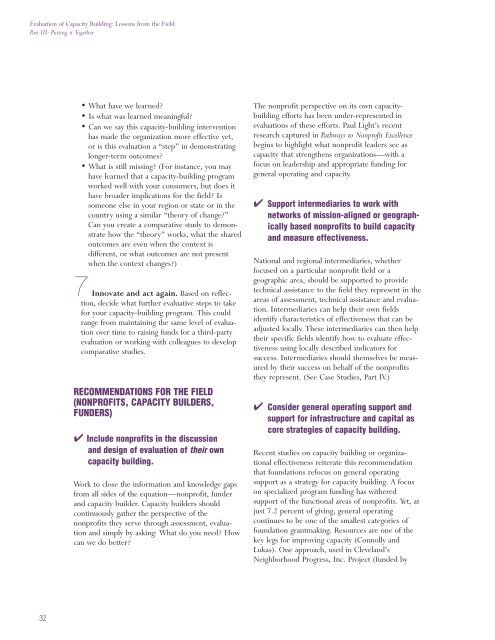Lessons from the Field - Seer Consulting
Lessons from the Field - Seer Consulting
Lessons from the Field - Seer Consulting
Create successful ePaper yourself
Turn your PDF publications into a flip-book with our unique Google optimized e-Paper software.
Evaluation of Capacity Building: <strong>Lessons</strong> <strong>from</strong> <strong>the</strong> <strong>Field</strong><br />
Part III: Putting it Toge<strong>the</strong>r<br />
32<br />
• What have we learned?<br />
• Is what was learned meaningful?<br />
• Can we say this capacity-building intervention<br />
has made <strong>the</strong> organization more effective yet,<br />
or is this evaluation a “step” in demonstrating<br />
longer-term outcomes?<br />
• What is still missing? (For instance, you may<br />
have learned that a capacity-building program<br />
worked well with your consumers, but does it<br />
have broader implications for <strong>the</strong> field? Is<br />
someone else in your region or state or in <strong>the</strong><br />
country using a similar “<strong>the</strong>ory of change?”<br />
Can you create a comparative study to demonstrate<br />
how <strong>the</strong> “<strong>the</strong>ory” works, what <strong>the</strong> shared<br />
outcomes are even when <strong>the</strong> context is<br />
different, or what outcomes are not present<br />
when <strong>the</strong> context changes?)<br />
7 Innovate and act again. Based on reflection,<br />
decide what fur<strong>the</strong>r evaluative steps to take<br />
for your capacity-building program. This could<br />
range <strong>from</strong> maintaining <strong>the</strong> same level of evaluation<br />
over time to raising funds for a third-party<br />
evaluation or working with colleagues to develop<br />
comparative studies.<br />
RECOMMENDATIONS FOR THE FIELD<br />
(NONPROFITS, CAPACITY BUILDERS,<br />
FUNDERS)<br />
✔ Include nonprofits in <strong>the</strong> discussion<br />
and design of evaluation of <strong>the</strong>ir own<br />
capacity building.<br />
Work to close <strong>the</strong> information and knowledge gaps<br />
<strong>from</strong> all sides of <strong>the</strong> equation—nonprofit, funder<br />
and capacity builder. Capacity builders should<br />
continuously ga<strong>the</strong>r <strong>the</strong> perspective of <strong>the</strong><br />
nonprofits <strong>the</strong>y serve through assessment, evaluation<br />
and simply by asking: What do you need? How<br />
can we do better?<br />
The nonprofit perspective on its own capacitybuilding<br />
efforts has been under-represented in<br />
evaluations of <strong>the</strong>se efforts. Paul Light’s recent<br />
research captured in Pathways to Nonprofit Excellence<br />
begins to highlight what nonprofit leaders see as<br />
capacity that streng<strong>the</strong>ns organizations—with a<br />
focus on leadership and appropriate funding for<br />
general operating and capacity.<br />
✔ Support intermediaries to work with<br />
networks of mission-aligned or geographically<br />
based nonprofits to build capacity<br />
and measure effectiveness.<br />
National and regional intermediaries, whe<strong>the</strong>r<br />
focused on a particular nonprofit field or a<br />
geographic area, should be supported to provide<br />
technical assistance to <strong>the</strong> field <strong>the</strong>y represent in <strong>the</strong><br />
areas of assessment, technical assistance and evaluation.<br />
Intermediaries can help <strong>the</strong>ir own fields<br />
identify characteristics of effectiveness that can be<br />
adjusted locally. These intermediaries can <strong>the</strong>n help<br />
<strong>the</strong>ir specific fields identify how to evaluate effectiveness<br />
using locally described indicators for<br />
success. Intermediaries should <strong>the</strong>mselves be measured<br />
by <strong>the</strong>ir success on behalf of <strong>the</strong> nonprofits<br />
<strong>the</strong>y represent. (See Case Studies, Part IV.)<br />
✔ Consider general operating support and<br />
support for infrastructure and capital as<br />
core strategies of capacity building.<br />
Recent studies on capacity building or organizational<br />
effectiveness reiterate this recommendation<br />
that foundations refocus on general operating<br />
support as a strategy for capacity building. A focus<br />
on specialized program funding has wi<strong>the</strong>red<br />
support of <strong>the</strong> functional areas of nonprofits. Yet, at<br />
just 7.2 percent of giving, general operating<br />
continues to be one of <strong>the</strong> smallest categories of<br />
foundation grantmaking. Resources are one of <strong>the</strong><br />
key legs for improving capacity (Connolly and<br />
Lukas). One approach, used in Cleveland’s<br />
Neighborhood Progress, Inc. Project (funded by


